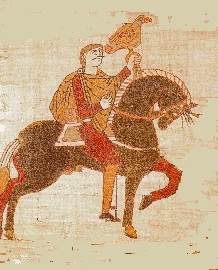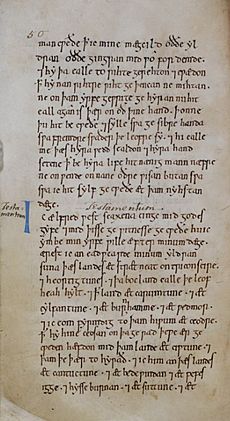Ancestry of the Godwins facts for kids

The Godwins were a very powerful family in Anglo-Saxon England. They are named after Earl Godwin, who was the father of Harold II. Harold II became the last Anglo-Saxon king of England.
When King Edward the Confessor died in January 1066, his closest relative was his great-nephew, Edgar the Ætheling. But Edgar was young and didn't have strong supporters. Harold, on the other hand, was the head of the most powerful family in England. He was also King Edward's brother-in-law. Because of this, Harold became king.
In September 1066, Harold fought and defeated King Harald Hardrada of Norway at the Battle of Stamford Bridge. Just one month later, Harold himself was defeated and killed by William the Conqueror at the famous Battle of Hastings.
The Godwin family became very rich and important in the 1020s. This happened under the Danish King Cnut the Great. In 1045, Godwin's daughter, Edith, married King Edward the Confessor. By the mid-1050s, Harold and his brothers had become super powerful. They almost controlled all the important earldoms (areas ruled by an earl) in England.
Godwin's own beginnings are a bit of a mystery. He was probably the son of Wulfnoth Cild. Wulfnoth was a South Saxon thegn (a type of noble or warrior). But even Wulfnoth's family history is debated. Some family researchers and historians think Wulfnoth was related to Alfred the Great's older brother, King Æthelred I (who ruled from 865–871). However, almost all historians who study Anglo-Saxon England don't believe this idea.
Contents
Godwin's Early Life
Earl Godwin might first appear in records around 1014. A document from that year mentions a Godwin, son of Wulfnoth. This Godwin was given land at a place called Compton in the will of Æthelstan Ætheling, who was King Æthelred the Unready's son. Since Earl Godwin later owned land at Compton in Sussex, it's likely he was the same person.
Historians believe Godwin was probably the son of Wulfnoth Cild. Wulfnoth was a South Saxon thegn who was declared an outlaw. In 1009, Wulfnoth was accused of unknown crimes. He then ran away with twenty ships from King Æthelred's fleet. A group of ships sent to catch him was destroyed in a storm.
The Life of Edward the Confessor was written for King Edward's widow, Edith. Edith was Harold's sister. This book doesn't say much about her family's origins. It praises Godwin as "blessed in his ancestral stock," but gives no more details. Historians often see this as avoiding the topic. Most historians don't believe a later story that Godwin was the son of a simple farmer.
Historian Robin Fleming calls Godwin "the quintessential new man." This means he was someone who rose to power without being born into a high-ranking family. However, other historians point out that the Anglo-Saxon Chronicle calls Wulfnoth "cild the South Saxon." The word cild means child, young man, or warrior. This suggests Wulfnoth was a person of some importance. His ability to take twenty ships from the royal fleet also shows he had local power. Some historians even argue that Godwin must have come from an aristocratic family. The large amount of land his family owned in Sussex strongly suggests that Wulfnoth, Godwin's father, was indeed a Saxon noble.
The Æthelred I Theory
A few scholars have suggested that the Godwins might be related to Alfred the Great's older brother, King Æthelred I of Wessex. This idea was first brought up in 1913.
This theory partly relies on tracking who owned certain estates, especially Compton in West Sussex. This Compton was likely the same land left to Æthelred I's son, Æthelhelm, in Alfred the Great's will. Later, Wulfnoth owned it, probably after his rebellion. Then, in 1014, it was left to "Godwin, Wulfnoth's son" in Æthelstan Ætheling's will.
Some historians, like Frank Barlow, have looked closely at this theory. He even included a family tree showing Godwin's possible link to Æthelred I in his book The Godwins. However, he also wondered why a family that used names starting with "Æthel-" or "Ælf-" for many generations would suddenly have a "Wulfnoth."
Most modern scholars, however, do not take this theory seriously. Many historians describe Godwin as one of King Cnut's "new men." This means he was someone who gained power because of his skills and loyalty, not because of his old family connections. They often say that Wulfnoth was a minor figure at court. Historians generally agree that Godwin's origins are very unclear.
Claim to the Throne
Even if Harold had been related to King Æthelred I, it wouldn't have automatically given him a right to the throne. In later Anglo-Saxon England, only "æthelings" could become king. An ætheling was a prince of the royal family who was considered worthy of the throne.
After the year 900, most known West Saxon æthelings were sons of kings. Harold's rival for the throne in 1066, Edgar the Ætheling, was an exception. He was the grandson of King Edmund Ironside. So, Edgar was an ætheling by some definitions. However, some historians believe that only the son of a current or former king could truly be an ætheling. When King Edward the Confessor called his great-nephew Edgar an ætheling, it was a special case.
Danish Family Connections
Godwin's wife, and the mother of his children (including Harold and Edith), was Gytha Thorkelsdóttir. Her father was Thorgils Sprakaleg, a Dane whose exact origins are unknown. He was probably from Scania, which was part of Denmark back then.
Gytha had very important family connections. Her brother, Ulf, married King Cnut's sister, Estrith. King Cnut likely arranged the marriage between Godwin and Gytha around 1022. This marriage helped Godwin gain even more power and influence.
See Also


